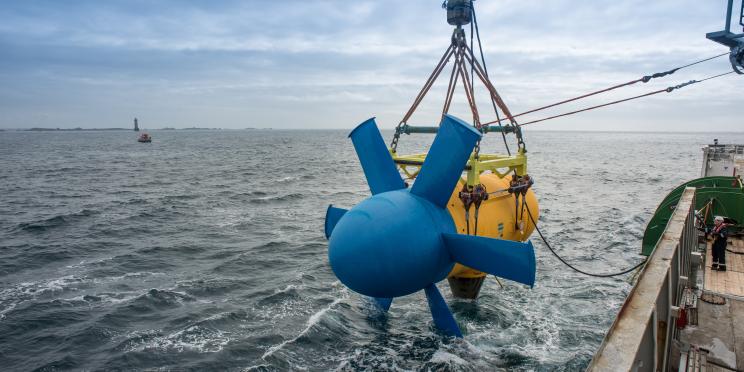TIGER project achieves milestones with completion of tests at Paimpol-Bréhat and new cooperation agreement
22/11/2021

A Memorandum of Understanding has been agreed by the French and UK marine energy councils and a next generation tidal turbine has been developed after a successful test site demonstration at Paimpol-Bréhat, Brittany.
These are two major milestones that will support the next stages of implementation for project TIGER, Interreg’s biggest ever project established to drive growth and accelerate deployment of tidal stream energy in the UK and France.
In September, after just over two years of testing in open waters, a 1MW tidal turbine designed by project partner HydroQuest and deployed at the EDF test site in Paimpol-Bréhat (Brittany) was disconnected from the electrical grid and transported to the port of Cherbourg for inspection.
Initially scheduled to last one year, funding from TIGER project supported a further year extension to make the most of the experiment.
These two years of continuous operation on the very demanding site of Paimpol-Bréhat have enabled HydroQuest to certify the power curve of the tidal machine and to prove its robustness. The characterisation of the marine tidal resource and the understanding of natural phenomena have also been significantly improved through the deployment.
Thanks to the thousands of hours of operation accumulated on its demonstrator in Paimpol-Bréhat, HydroQuest has designed a next generation of tidal turbine which is even more efficient and more powerful, whilst being lighter providing a competitive edge. These next generation tidal turbines will be deployed at a pilot farm of 7 machines of 2.5MW of unit power at the Raz Blanchard, in Normandy.
The pilot farm will be operated for a period of 20 years and will produce 40 GWh/year, equivalent to the consumption of 20,000 people. This project contributes to the European Union’s objective of 100MW of marine renewable energy, excluding wind power, to be commissioned by 2025. This is a crucial development for the Raz Blanchard site which offers the largest tidal resource in the EU with the potential to supply two million people with renewable energy.
During recent months, TIGER project partners also ran preparatory campaigns in the French Gulf of Morbihan and the UK’s Yarmouth Harbour test sites, where the team plan to adapt the design of tidal installations to these specific areas. The measurement of the seabed at the Gulf of Morbihan by project partners SEENEOH, Université de Bretagne-Sud and Morbihan Hydro Energies is documented in the video below:
These substantial developments have been supported by a new Memorandum of Understanding signed by the French Renewable Energies Trade Association, Syndicat des Energies Renouvelables and the UK Marine Energy Council.
This agreement further tightens the Franco-British cooperation kickstarted by TIGER and lays the groundwork for continued common initiatives across the Channel, long after the end of the project. Through this agreement, the two partners formally commit to sharing intelligence, best practice and jointly collaborating on key actions in the field of renewable marine energies.
This partnership will enhance the objectives of project TIGER to address common issues in the sector such as lowering costs, organising the local value chain and developing sites. It will also help the project make a stronger, cost-effective case for tidal stream energy in the UK and France.
Several actions have taken place recently to increase support in the UK. A recent study published in Proceedings of the Royal Society and led by project partner University of Plymouth just before the opening of COP26, highlighted the potential for tidal stream energy to deliver 11% of the UK’s current annual electricity and play a significant role in the government’s drive for net-zero.
Scientists from across the UK say that harnessing the power of the ocean’s tidal streams can provide a predictable and reliable means of helping to meet the UK’s future energy demand. However, if that is to be realised, it will require government funding via initial subsidy of energy generation costs. According to industry experts, this ongoing support is normal for any pre-commercial technology to encourage private investment, accelerate innovation and collectively drive down cost so that future projects can provide affordable electricity.
Simon Cheeseman, head of tidal and wave power at TIGER lead partner Offshore Renewable Energy (ORE) Catapult advocated this point in an interview with the Daily Telegraph in October, where he called for a ring-fenced amount dedicated to tidal stream energy in governmental investment plans.
Referring to analysis by ORE Catapult, he pointed out that a £1 billion subsidy investment over 10 years would be needed to bring down the price of tidal energy to a competitive £90 Megawatt/hour. This, in turn, could create 14,500 jobs while a strengthened tidal stream sector could contribute £4 billion to the British economy by 2040.
As Simon Cheeseman concludes in the Telegraph: “The technology is ready, it can be made in the UK, it’s great for levelling up. We just need to get the market conditions right for tidal power in the way we created a market for wind.”
TIGER project is an ambitious €45.4m project, of which €29.9m (66%) comes from the European Regional Development Fund via the Interreg France (Channel) England Programme. The TIGER project was launched in October 2019 and will be completed in 2023.
More information:
• TIGER video: https://www.youtube.com/watch?v=JjHmd7bafjI
Photo credit:
Sabella 2019. Copyright balao.
